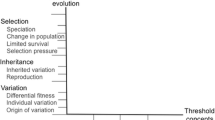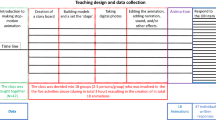Abstract
We investigated potential drivers of interest in topic–context and topic–activity combinations, as well as interactions between the different elements of situational interest in evolutionary biology. High school students (n = 982, age 17 years) were asked to rate their interest in two sets of items consisting of topic–context and topic–activity combinations. Rasch modeling, analyses of variance, and descriptive statistics revealed that topics are the dominant dimension and moderate the general level of interest that students express in both topic–context and topic–activity combinations. Qualitative findings from interviews with high school students (n = 6, age 16 years) support this finding. Thus, choice of a particular context, as well as choice of a particular activity, may be less important than previously assumed, since topics are the bottleneck and drive situational interest in topic–context combinations and topic–activity combinations. Implications for evolution education are discussed.


Similar content being viewed by others
References
Akaike, H. (1981). Likelihood of a model and information criteria. Journal of Econometrics, 16(1), 3–14.
Baram-Tsabari, A., & Yarden, A. (2007). Interest in biology: a developmental shift characterized using self-generated questions. The American Biology Teacher, 69(9), 532–540.
Bathgate, M. E., Schunn, C. D., & Correnti, R. (2014). Children’s motivation toward science across contexts, manner of interaction, and topic. Science Education, 98(2), 189–215.
Bennett, J., Lubben, F., & Hogarth, S. (2007). Bringing science to life: a synthesis of the research evidence on the effects of context-based and STS approaches to science teaching. Science Education, 91(3), 347–370.
Dawson, C. (2000). Upper primary boys’ and girls’ interests in science: have they changed since 1980? International Journal of Science Education, 22(6), 557–570.
De Jong, O. (2008). Context-based chemical education: how to improve it? Chemical Education International, 8(1), 1–7.
Dunk, R. D. P., Petto, A. J., Wiles, J. R., & Campbell, B. C. (2017). A multifactorial analysis of acceptance of evolution. Evolution: Education and Outreach, 10(1), 1–8.
Donnelly, L. A., Kazempour, M., & Amirshokoohi, A. (2009). High school students’ perceptions of evolution instruction: acceptance and evolution learning experiences. Research in Science Education, 39(5), 643–660.
Frasier, T. R., & Roderick, C. (2011). Improving how evolution is taught: facilitating a shift from memorization to evolutionary thinking. Evolution: Education & Outreach, 4, 298–307.
Gilbert, J. K. (2006). On the nature of “context” in chemical education. International Journal of Science Education, 28(9), 957–976.
Häussler, P. (1987). Measuring students’ interest in physics: design and results of a cross-sectional study in the Federal Republic of Germany. International Journal of Science Education, 9, 79–92.
Häussler, P., & Hoffmann, L. (2000). A curricular frame for physics education: development, comparison with students’ interests, and impact on students’ achievement and self-concept. Science Education, 84(6), 689–705.
Häussler, P., Bünder, W., Duit, R., Graeber, W., & Mayer, J. (1998). Naturwissenschaftsdidaktische Forschung—Perspektiven für die Unterrichtsforschung (Research in science education—perspectives for classroom research). Kiel: IPN.
Hidi, S. (2001). Interest, Reading, and learning: theoretical and practical considerations. Educational Psychology Review, 13(3), 191–209.
Hidi, S., & Renninger, K. A. (2006). The four-phase model of interest development. Educational Psychologist, 41(2), 111–127.
Hillis, D. M. (2007). Making evolution relevant and exciting to biology students. Evolution, 61(6), 1261–1264.
Holstermann, N., Grube, D., & Bögeholz, S. (2010). Hands-on activities and their influence on students’ interest. Research in Science Education, 40(5), 743–757.
Hulleman, C., & Harackiewicz, J. (2009). Promoting interest and performance in high school science classes. Science, 326, 1410–1412.
Jördens, J., Asshoff, R., Kullmann, H., Tyrrell, S., & Hammann, M. (2011). Situational interest in evolutionary topics, contexts and activities. In A. Yarden & G. C. Carvalho (Eds.), Authenticity in biology education. Benefits and challenges. A selection of papers presented at the VIIIth Conference of European Researchers in Didactics of Biology (ERIDOB) (pp. 225–236). Braga, Portugal: Universidade do Minho.
Krapp, A. (2002). Structural and dynamic aspects of interest development: theoretical considerations from an ontogenetic perspective. Learning & Instruction, 12, 383–409.
Krapp, A., & Prenzel, M. (2011). Research on interest in science: theories, methods, and findings. International Journal of Science Education, 33(1), 27–50.
Mayring, P. (2000). Qualitative content analysis. Forum: Qualitative Social Research, 1(2). http://www.qualitative-research.net/index.php/fqs/article/view/1089/2385. Accessed 7 Feb 2018.
McKeachie, W. J., Lin, Y., & Strayer, J. (2002). Creationist vs. evolutionary beliefs: effects on learning biology. The American Biology Teacher, 64, 189–197.
Nationale Akademie der Wissenschaften Leopoldina (2017). Evolutionsbiologische Bildung in Schule und Hochschule—Bedeutung und Perspektiven (Evolution education in schools and at universities—importance and perspectives). Halle: Deutsche Akademie der Naturforscher Leopoldina e.V. Nationale Akademie der Wissenschaften.
Nelson, C. E. (2008). Teaching evolution (and all of biology) more effectively: strategies for engagement, critical reasoning, and confronting misconceptions. Integrative & Comparative Biology, 48(2), 213–225.
Palmer, D., Dixon, J., & Archer, J. (2017). Using situational interest to enhance individual interest and science-related behaviours. Research in Science Education, 47, 731–753.
Potvin, P., & Hasni, A. (2014). Interest, motivation and attitude towards science and technology at K-12 levels: a systematic review of 12 years of educational research. Studies in Science Education, 50(1), 85–129.
Renninger, K. A., & Hidi, S. (2016). The power of interest for motivation and engagement. New York, N.Y.: Routledge.
Rotgans, J. I., & Schmidt, H. G. (2014). Situational interest and learning: thirst for knowledge. Learning and Instruction, 32, 37–50.
Schiefele, U., Krapp, A., & Schreyer, I. (1993). Metaanalyse des Zusammenhangs von Interesse und schulischer Leistung (Meta-analysis of the relationship between interest and academic performance). Zeitschrift für Entwicklungspsychologie und Pädagogische Psychologie, 10(2), 120–148.
Swarat, S. (2008). What makes a topic interesting? A conceptual and methodological exploration of the underlying dimensions of topic interest. Electronic Journal of Science Education, 12(2), 1–26.
Swarat, S., Ortony, A., & Revelle, W. (2012). Activity matters: understanding student interest in school science. Journal of Research in Science Teaching, 49, 515–537.
Wilson, D. S. (2005a). Evolution for everyone: how to increase acceptance of, interest in, and knowledge about evolution. PLoS Biology, 3(12), 2058–2065.
Wilson, M. (2005b). Constructing measures. An item response modeling approach. Mahwah, N.J.: Routledge.
Wilson, M., deBoek, P., & Carstensen, C. H. (2008). Explanatory item response models: a brief introduction. In J. Hartig, E. Klieme, & D. Leutner (Eds.), Assessment of competencies in educational contexts (pp. 91–120). Cambridge, MA: Hogrefe.
Witzel, A. (2000). The problem-centered interview. Forum: Qualitative Social Research, 1(1). http://nbn-resolving.de/urn:nbn:de:0114-fqs0001228. Accessed 7 Feb 2018.
Wu, M. L., Adams, R. J., Wilson, M. R., & Haldane, S. A. (2007). ACER ConQuest version 2.0: generalised item response modelling software. Camberwell: ACER Press.
Acknowledgements
This study was conducted in the context of “Design and Evaluation of Teaching Materials for the Evolution of Life,” a project funded by VolkswagenStiftung on the occasion of Charles Darwin’s 200th birthday. We would like to thank Prof. Dr. Erich Bornberg-Bauer, Dr. Harald Kullmann, Dr. Roman Asshoff, Mayalin Scholz, and the reviewers for their contributions.
Author information
Authors and Affiliations
Corresponding author
Ethics declarations
Conflict of Interest
The authors declare that they have no conflict of interest.
Additional information
Publisher’s Note
Springer Nature remains neutral with regard to jurisdictional claims in published maps and institutional affiliations.
Electronic Supplementary Material
Online Resource 1
(DOCX 40 kb)
Online Resource 2
(DOCX 42.7 kb)
Rights and permissions
About this article
Cite this article
Jördens, J., Hammann, M. Driven by Topics: High School Students’ Interest in Evolutionary Biology. Res Sci Educ 51, 599–616 (2021). https://doi.org/10.1007/s11165-018-9809-5
Published:
Issue Date:
DOI: https://doi.org/10.1007/s11165-018-9809-5




